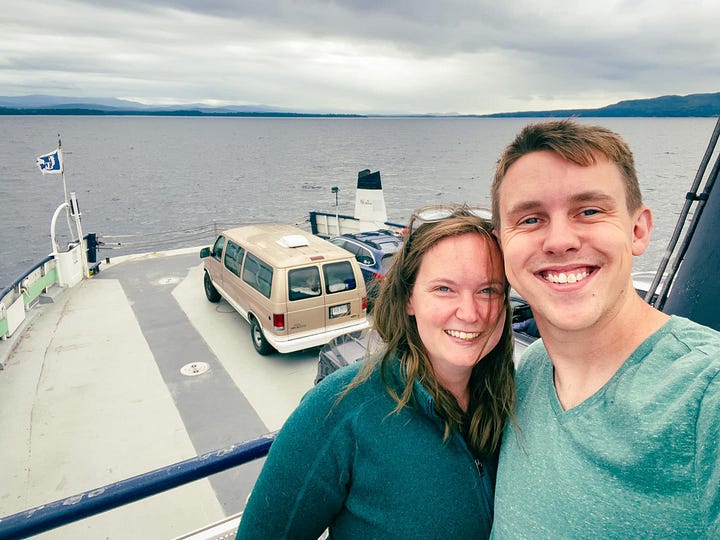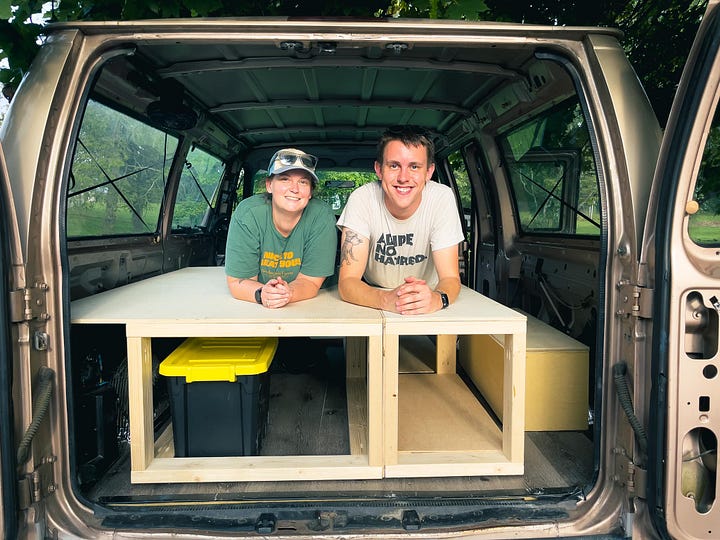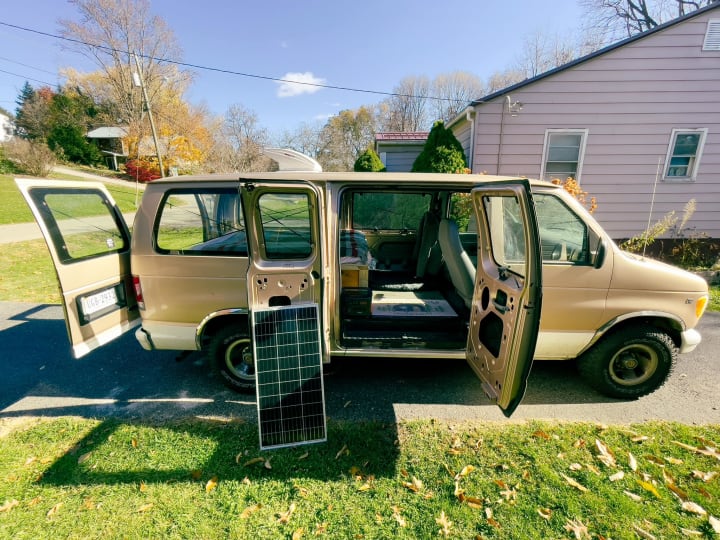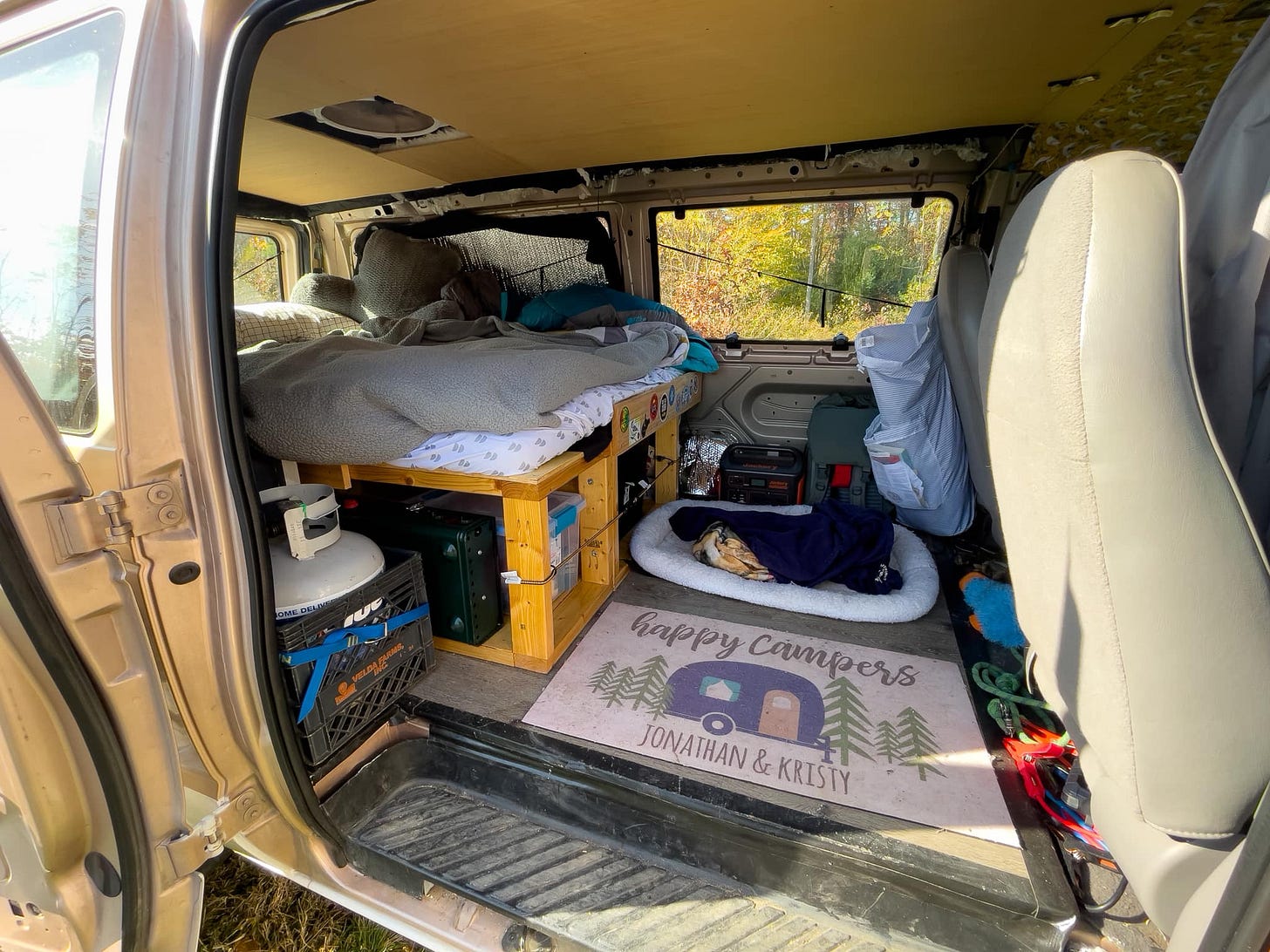Lessons Learned from the Van
A project of endless iteration and so much fun along the way.
Kristy and I purchased our van on August 30th, 2020. 1,254 days so far with a 1998 Ford Club Wagon, a low top E-150 van we found on Facebook Marketplace for $2200. It had low miles—still does—and the freshest set of Wrangler AT tires you’ve ever seen on a cheap vehicle, little rubber nubbins still hanging on.
We drove a little ways away to Bedford, Virginia, paid in $20 bills we’d been stacking in a mason jar (ask me how we’re saving for our wedding now…), and got the keys. I drove the van back home with Kristy following me in her Subaru. Almost immediately, the airbag light came on and the ignition ding started playing every few minutes.
To the uninitiated, dash lights and errant noises might have been a harbinger for what’s to come. But I’m no stranger to the peculiar issues of 1990’s vehicles and certainly not above the liberal use of black electrical tape on a dashboard. My 1997 Jeep Cherokee (that I still had at the time) taught me a whole lot about unreliable and ridiculously fun cars. We were ready for a project and the van has given us that so many times over.
Incidentally, the airbag light quickly solved itself for years when that side of the dash’s lights burned out, or so I thought. I hit a bump in Hinton, West Virginia last weekend and it lit right back up. Surmountable problems.
Building out the van was a blast. On the tail of the pandemic, we still had free time to devote to projects and spend countless hours making this van our own.
Eventually, we ended up with an insulated floor, bed platform, underneath storage, a battery system, roof fan, and a completely re-worked HVAC system that went from dripping Stop Leak in my mouth while I cut and capped the labyrinth of lines to blowing ice cold air out the front all over the course of a couple weekends.
That’s when we said “good enough” and did our biggest trip so far: upstate New York, Vermont, New Hampshire, and a rainy interstate slog back home.




That trip brought us closer with two sweaty humans and two big dogs in a pretty small van. We fell in love with upstate New York and ended up going back again, leaving the van in Virginia the next time and staying indoors when the temperatures weren’t forecasted to get over 10 degrees F all trip. We have another winter trip planned up there soon!
We’ve learned a few things about vanning, about ourselves, and about how we like to travel since we started this journey.
Today, I wanted to share a noncomprehensive list of lessons, tips, and candid advice:
A van doesn’t have to cost that much.
Vanlife influencers lead you to believe that you need a fancy, built-out Mercedes Sprinter that costs the same as a modest home. When you’re out on the road, you’ll see a lot of those too. But we built a van for frequent weekends. It’s comfortable for a week and probably longer but it’s not fancy or perfectly assembled.
Save some dollars in a mason jar, spend a week or two on Facebook Marketplace, and find a cheap van to start with. You’ll need a couple weekends of work to get it going. If you’re lucky, you can find a van somebody started on and got impatient.
Building a van on a budget can be done for less than a single trip to Disney World and you’ll have it for years to come.Decide if standing up is important to you.
A high-top vs. low-top van will be one of the first decisions you’ll have to make and the hardest to remedy later on. Just like 4WD (see below), it will also effect your budget, vehicle choices, and so much about the design.
We built a weekend van, not one to live in full-time. Low-top works for us and we can still sit in camp chairs inside just fine. The low roof lets us go more places, like the McDonald’s drive-thru. Still, if we were doing this for long-term living I’d like to be able to change clothes standing up.Build in as much storage as you possibly can.
Our first trip out was the worst one. We put a futon mattress on the floor and threw our stuff inside. It was cramped, unorganized, and annoying. Our stove didn’t work either and I ended up making dinner over a fire in a drainage ditch. Since then, though, “Ditch Scampi” is a mainstay camping meal of ours!
Build in storage. Get creative. Optimize every trip.It will ruin tent camping for you forever.
If you simply put a mattress in a vehicle, have a roof over your head, a window cracked, and the freedom to drive off without dismantling a wet tent the next day, you won’t go back.
We haven’t done many backpacking trips since we got the van and none successfully. The van is an amazing basecamp and I’d much rather run a trail instead of hike it and end up at the comfy van each night. Out west, I think this would be different. Here in the east, we just don’t have that many places that aren’t accessible with a long day trip.Ventilation is important. Insulation is too (I’m pretty sure)
The roof fan makes everything possible. It keeps you cool in the summer, comfortable in the winter, and keeps you from fogging up your boogie van every night. Cutting a big hole in your roof seems scary but it’s really not, I promise. You want a roof fan. If you live where it’s really hot, you want an AC. It’s the same size hole.
Insulation matters too, at least I think so. We insulated everything pretty much immediately so I can’t say for sure but the Thinsulate on the walls and three-layer-thick flooring really keeps the van warmer in winter, cooler in summer, and quieter on the interstate.
I wish we didn’t have any windows. It would be easier to build and insulate more. Some day we might replace them with sheet metal.Bring backup systems and some tools.
If your van has some years on it like ours, it will not start every single time. It’s fine but you need to plan for backups when it’s too cold, the van was sitting too long, you left the lights on, etc.
First, disable every interior light that can drain the battery. Interior lights are great for in-town but you want to take your van some places. Remove the risk for human error.
Carry jumper cables—to jumpstart other cars—and a jump box to start yours. Don’t use the jump box to help others. That’s your insurance to get out yourself.
Carry some tools but don’t go overboard. I have a socket set, electrical tools, and enough hand tools to swap the starter or other minor repair job on the road.
When you get beyond easy repairs, you’ll be making memories anyway and sitting in a garage or Advance Auto parking lot and they have tools.You use way more water than you think you do.
We’re still working on this one. We use a ton of water. Our dog drinks a ton. Dishes take water. And now we have a shower too.
12 gallons isn’t enough. We need to work on a bigger tank solution and a hard-wired pump.Battery power is awesome. Campground electric hookups? Who needs ‘em!
We have a Jackery 1000 battery pack and inverter. We have a single 100w solar panel that can charge what we use nightly by the time we finish breakfast on a partly cloudy morning.
The battery system is great. We also went to some lengths to create a safe and reliable shore power plug to hook up at campgrounds. We haven’t used it even once.
When all you’re doing is running lights, fans, charging devices, and operating an electric kettle once a day, you really don’t need that much battery capacity. A water hookup is very nice to have but electricity is easier to off-grid and campground hookups can double the price of a spot.You probably don’t need 4 Wheel Drive.
We have a really excellent set of all terrain tires that came with the van. Those have gotten us into and out of every situation so far.
We’ve taken the van some bad places: doubletrack logging roads that mostly see ATVs, boulder-specked pasture land that tested the ground clearance, and steep cliffside “roads” deep in West Virginia hollers.
We’ve had no need for 4WD. Think long and hard about going the 4x4 route before you do. It adds incredible expense and as far as we’ve seen, not a lot of utility. We have a big, heavy van with the weight over the rear drive tires. At this point, I’m waiting to see what finally gets us stuck.You shouldn’t try and travel everyday.
I’m learning this lesson. Kristy probably already knew it. It’s more fun to stay in camp, do crafts, drink tea, and relax than drive everyday. Travel days are the expensive days too: gas, fast food, and mechanical problems.
Van camping is about taking it easy.People will stop you and talk about it all the time.
There’s nothing to this one but just a reminder to be kind. People are drawn to this stuff: building a van, the freedom of the road, the romantic ideal. It’s awesome. Just remember to slow down and talk to people about it. You never know who you’ll meet!
That’s a good list to start. Mainly the point to drive home: if you’re considering a camper van, do it! And nothing to disparage a fancy one either. We just did it our way. If having a nice van, reliable systems, and a warranty will get you out of the road more, that’s what matters.
If you have any questions about our van, want to talk with us or see it, leave a comment and get in touch!





Just glad you didn’t go with a white panel van. That with a mustache is a bad combo! Lol
While not my lifestyle I think it is really cool what you are building there. Seems so fun and relatively care free.
Love it!